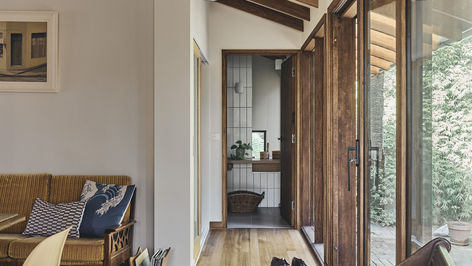
engawa house
-
The owners of this 100-year-old character cottage in the Melbourne suburb of Ivanhoe, a professional couple and their teenaged daughter, had the pressing need to update their kitchen, laundry and bathroom, and to improve opportunities for living and leisure space. Faced with some awkward planning from ad hoc adjustments over the years, the limited internal / external connection of the existing layout, and poor thermal performance typical of aged homes of this era, the renovation demanded a broader focus than refurbishment alone. Located at the front of a densified battle-axe subdivision, the project required an intricate and tailored approach.
On a modest site of less than 400m2 with a 6.5m rear setback covenant - both by-products of the earlier subdivision - the scope for extension was severely limited. It was integral to take a forensic approach toward re-organisation of the existing space. The desire for more leisure space and improved garden connection, for the most part within the existing footprint, demanded reconsidering what was already there; any addition to the house had to work hard and earn its keep.
From the outset, the existing house exuded a comfortably eccentric aura. Looking at the street façade, the house’s previous renovations are evident in its charming assemblage of terracotta roof, brick chimney and part-weatherboard, part-stucco frontage. The new yet subtle additions are another chapter in the house’s evolution over time.
For the interior, the primary goal was to provide a backdrop for the clients’ collections to be on full display. The home is unapologetic, revelling in the pleasant messiness of living with things. The re-organisation of the rear part of the house saw the floor plan simplified by swapping the kitchen and dining areas, allowing flow through the centre of the house, the modest linking addition and out to the rear garden. Straddling the line between function and form, the kitchen’s natural ledges, nooks and integrated shelving create opportunities for display and breakdown the discrete definition between spaces with differing functions. The re-orientation intentionally blurs the edges of the kitchen, allowing it to borrow from, and importantly give to, the adjoining supporting spaces.
As avid travellers and lovers of art and literature the owners have amassed a wide collection over the years. Inspired by this, the house was designed as a celebration of their love of ‘things’: the objects, mementos and artefacts that are part of their authentic, everyday life, all proudly on display. A subdued yet confident approach, favouring simplicity and honesty to materiality and form, ensured that each article, from their books, music, art, a Tanuki statue, to a taxidermy turkey, deserved an equal spectacle within their home.
In Japanese architecture, the engawa or ‘en’, meaning edge, is a transitional zone resembling a sunroom or porch, that runs around or along an interior space. The engawa allows flexibility, either opening-up or providing enclosure to the interior. This strategy is employed throughout the home but is most apparent at the rear, where the internal hallway (abutting the new cupboard-style laundry and providing access to the reconfigured bathroom) is mirrored externally with a narrow deck.
*Words taken from Inbetween Architecture.
Product Selection:
Stain Colour: Maple
Designed by: Inbetween Architecture
Photographed by: Peter Bennets














